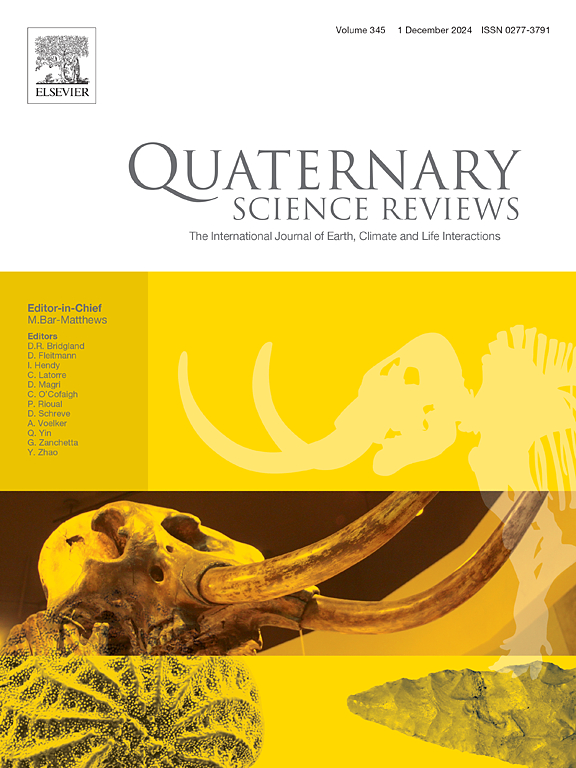Time-transgressive response of benthic foraminifera to the deglaciation of the Northeast Greenland shelf
IF 3.2
1区 地球科学
Q1 GEOGRAPHY, PHYSICAL
引用次数: 0
Abstract
Proxy-based reconstructions are imperative for understanding long-term ice dynamics, ecological conditions, and oceanographic variability following the deglaciation due to the temporal limitation of instrumental records. This study examines the response of benthic foraminiferal assemblages to the deglaciation of the Northeast Greenland shelf based on three sediment cores from the Belgica Trough (∼77°N), testing to which degree the foraminifera show a consistent response to environmental change. Recent studies from the Belgica Trough reveal that the shelf edge was deglaciated before 16.6 cal ka BP through a stepwise ice retreat, followed by a rapid retreat through the inner shelf, likely before 12.5 cal ka BP. The results of this study reveal the subsequent development of the deglaciated marine environment to exhibit a consistent time-transgressive foraminiferal assemblage succession across the core sites, delineated by three distinct foraminiferal zones. This allows us to further improve previous reconstructions of the deglacial-Holocene paleoenvironmental and paleoceanographic development of the shelf. It also highlights the sensitivity of benthic foraminifera towards the complex interaction between ice dynamics, ecological conditions, and oceanographic variability, proving their reliability and consistency as a proxy. Comparisons with other Arctic deglacial successions suggest the potential for identifying standard assemblages to recognize specific stages in a deglacial succession: Assemblages characterized by the species Stetsonia horvathi, Stainforthia concava, and Glomulina oculus appear as a reliable indicator of sub-ice shelf conditions following deglaciation, while stable higher salinity conditions often found during periods of influx of Atlantic-derived water is characterized by Cassidulina neoteretis, Cassidulina reniforme, and Islandiella norcrossi. High-productivity environments are advantageous for Melonis barleeanus, Stainforthia feylingi, and other eutrophic species, and these species thus make out a reliable standard for recognizing productive paleoenvironments often linked to ice edges or seasonal sea ice. Dissolution of calcareous taxa, and dominance of agglutinated taxa characterize cold, corrosive bottom water conditions and/or periods of brine formation.
底栖有孔虫对格陵兰东北陆架冰消的时间-海侵响应
由于仪器记录的时间限制,基于代理的重建对于理解冰川消融后的长期冰动力、生态条件和海洋变率是必要的。本研究基于比利时海槽(~ 77°N)的三个沉积物岩心,研究了底栖有孔虫组合对格陵兰东北陆架冰川消退的响应,测试了有孔虫对环境变化的一致响应程度。最近对比利时海槽的研究表明,在16.6 cal ka BP之前,大陆架边缘通过逐步的冰退缩而消融,随后大陆架内部迅速退缩,可能在12.5 cal ka BP之前。本研究结果揭示了脱冰海洋环境的后续发展,在岩心遗址上表现出一致的时间-海侵有孔虫组合演替,由三个不同的有孔虫带划分。这使我们能够进一步改进以前对冰期-全新世陆架古环境和古海洋学发展的重建。它还强调了底栖有孔虫对冰动力、生态条件和海洋变率之间复杂相互作用的敏感性,证明了它们作为代理的可靠性和一致性。与其他北极去冰演替的比较表明,有可能通过确定标准组合来识别去冰演替的特定阶段:以Stetsonia horvathi、stanforthia concava和Glomulina oculus为特征的物种组合是冰川消退后冰架下条件的可靠指标,而在大西洋源水流入期间经常发现的稳定的高盐度条件是Cassidulina neteretis、Cassidulina reniforme和Islandiella norcrossi。高生产力的环境有利于barleeanus Melonis, stanforthia feylingi和其他富营养化物种,因此这些物种为识别通常与冰缘或季节性海冰有关的生产性古环境提供了可靠的标准。钙质分类群的溶解和凝集分类群的优势是寒冷、腐蚀性底水条件和/或盐水形成时期的特征。
本文章由计算机程序翻译,如有差异,请以英文原文为准。
求助全文
约1分钟内获得全文
求助全文
来源期刊

Quaternary Science Reviews
地学-地球科学综合
CiteScore
7.50
自引率
15.00%
发文量
388
审稿时长
3 months
期刊介绍:
Quaternary Science Reviews caters for all aspects of Quaternary science, and includes, for example, geology, geomorphology, geography, archaeology, soil science, palaeobotany, palaeontology, palaeoclimatology and the full range of applicable dating methods. The dividing line between what constitutes the review paper and one which contains new original data is not easy to establish, so QSR also publishes papers with new data especially if these perform a review function. All the Quaternary sciences are changing rapidly and subject to re-evaluation as the pace of discovery quickens; thus the diverse but comprehensive role of Quaternary Science Reviews keeps readers abreast of the wider issues relating to new developments in the field.
 求助内容:
求助内容: 应助结果提醒方式:
应助结果提醒方式:


